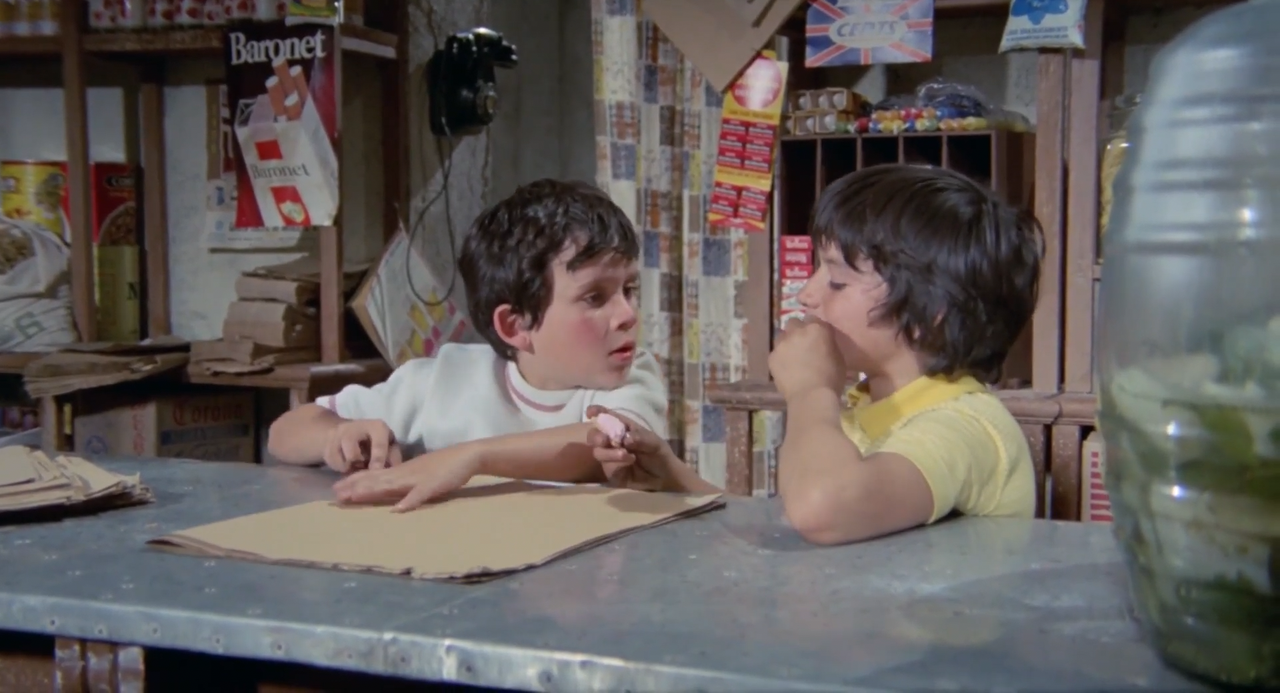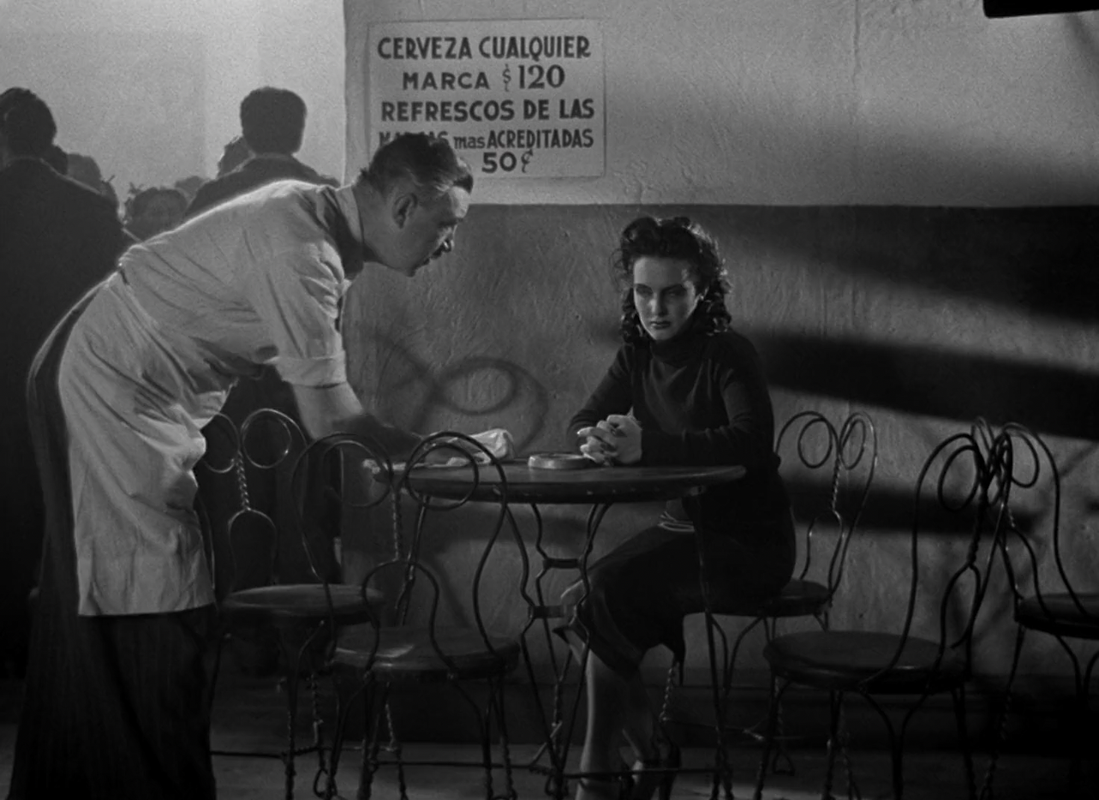– You know what's really awful? – No, tell me. – Getting hooked. It's the end. But, if you only take one shot every once in awhile. Its no different than an occasional drink or cigarette.More (Barbet Schroeder, 1969)
Aug
22
Munchies

Druggies Estelle (Mimsy Farmer) and Stefan (Klaus Grünberg) eating straight from a jar of honey and picking crumbs out of a loaf of bread. There's Coca-Cola product placement and half-eaten foods everywhere. DP: Néstor Almendros.
crime
Hell Bound (William J. Hole Jr., 1957)
Aug
20
milk

Stanley Thomas (George E. Mather) and Daddy (Dehl Berti) in a sleazy nightclub. Daddy raises his glass of milk to someone offscreen. DP: Carl E. Guthrie.
Hell Bound (William J. Hole Jr., 1957)
Aug
20
International Day Of Medical Transporters

Paula (June Blair) and Eddie (Stuart Whitman) in nurses' uniforms taking care of an injured child on the street. Behind them, two cops unload a stretcher from an ambulance. DP: Carl E. Guthrie.
The boss' girlfriend falls for an ambulance driver, derailing her man's gang's carefully planned narcotics heist.
Matinée (Jaime Humberto Hermosillo, 1977)
Aug
19
free candy

Best friends Aarón (Rodolfo Chávez Martínez) and Jorge (Armando Martín) helping out in Aarón's parents' convenience store while helping themselves to a snack or two. DP: Jorge Stahl Jr..
Maléfices [Where the Truth Lies] (Henri Decoin, 1962)
Aug
16
milk

Ronga (Maîthé Mansoura accompanied by cheetah Nyète), sits on a straw-covered floor while holding a bowl with milk. There are potted plants and gardening equipment is placed against the wall. DP: Marcel Grignon.
Salón México (Emilio Fernández, 1949)
Aug
13
$120 cerveza

Mercedes (Marga López) sitting at a small round table at the salón. A waiter just came over to take her order. In the other room, meticulously dressed couples dance to live music. DP: Gabriel Figueroa.
L'œil du malin [The Eye of Evil / The Third Lover] (Claude Chabrol, 1962)
Aug
8

A table covered with a neatly ironed table cloth and on it, several stacks of flat and soup plates, plus silverware and nesting aluminium pans. DP: Jean Rabier.
“The sun looks ghostly when there's a mist on a river and everything's quiet. I never knowed it before.”Days of Heaven (Terrence Malick, 1978)
Aug
7
Alberta Heritage Day

Bill (Richard Gere) and Abby (Brooke Adams) walking through golden fields towards a small pavilion. DP: Néstor Almendros.
Quintessential Americana. Filmed in Canada.
– Linda
“These children that come at you with knives, they are your children. You taught them. I didn't teach them. I just tried to help them stand up.” Manson (Robert Hendrickson + Laurence Merrick, 1973)
Aug
6
American Family Day

A large group of hippies somewhere outside in front of canopy. They appear to be mid-song, posing as if in a stage play. One of them wears a T-shirt with a Christ-like, bearded man on it. On closer inspection, some familiar faces. Captions reads “The Family”. DPs: Jack Beckett & Louie Lawless.
Everything America stood for – God, liberty and justice for all – fell apart in the 60s. A much-loved president and family man killed on live television. Teenagers shipped to a country many never heard of before, only to end up as cannon fodder. Peace loving middleclass white kids from well-to-do families gathering en masse in Haight-Ashbury, collectively fell to bum trips and bouts of gonorrhoea. What America needs is family. Someone who takes you in, understands you, sings you songs and feeds you. An older man with friendly eyes appears on the scene, doing just that.
– Charles Manson, testimony
What the press dubbed The Family was a microcosm of American society; a loose collective of lost kids. Taken in by charismatic peddling pimp #CharlieManson with a steady supply of #LSD and a place to be themselves, rootless kids like Lynette “#Squeaky” Fromme and Paul Watkins were finally part of a family again. The family grew too; besides more lost souls and the occasional Beach Boy visiting Spahn Ranch, babies were born at the Devil's Slide.
Hendrickson and Merrick's Manson offers a candid and by times surreal portrait of a few #MansonFamily members (Squeaky makes out with a riffle, purring about how killing is like having an orgasm while Atkins lays out her plans to murder Frank Sinatra) right in the middle of the spectacle [sic] court-case. It was even nominated for an Oscar – which went to that other charismatic 70s evangelist, Marjoe (1972), while Manson was banned after Fromme's botched assassination attempt on President Gerald Ford in '75 and was lost for decades.
Stylistically inspired by Woodstock (1970) and soundtracked by the Family themselves, Manson remains a fascinating curio in the undying output of #Mansonsploitation movies. However gruesome, the American family is forever cemented in that holy cornerstone of self-immolation.
“How about you slip into something more comfortable, like a few drinks and some Chinese food?”The Blue Gardenia (Fritz Lang, 1953)
Aug
5
International Hangover Day

Norah (Anne Baxter) and Harry (Raymond Burr) sharing a meal – and a drink (or two) – at the Blue Gardenia Club. DP: Nicholas Musuraca.
After a horrible birthday alone followed by a lovely night out, Norah wakes up with a terrible hangover and a hunch of being a murderess.
– Harry
The Blue Gardenia is Lang's hard-bitten take on the gruesome Black Dahlia murder case and part of his newspaper noir trilogy together with While the City Sleeps and Beyond a Reasonable Doubt, both from 1956.